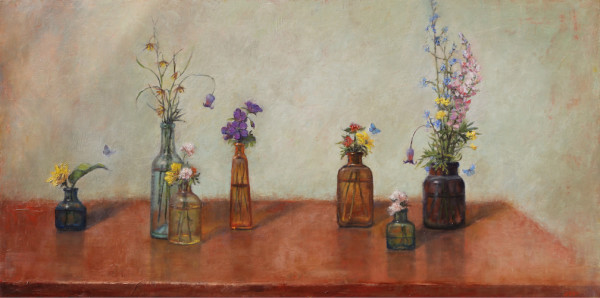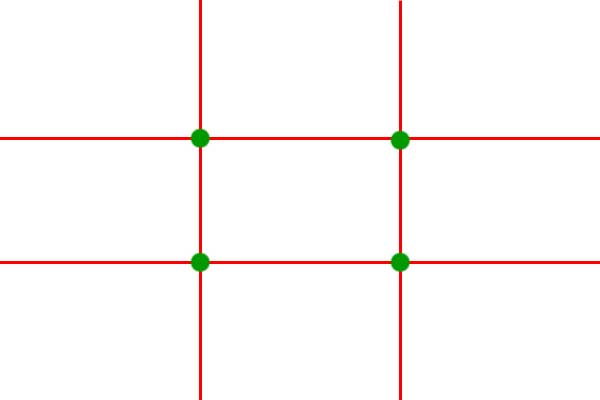The Rule of Thirds is probably one of the most basic rules that has been used in painting for ages. It is a compositional rule of thumb that is commonly used in the visual arts today including painting, photography and design.
This is a very basic rule about that is often overlooked by amateur artists and forgotten by many art teachers. Interestingly, it is one of the most important rules that a novice photographer learns about in photography class! Using it will help improve the design of your paintings.
In art, rules are made to be broken! The artist should be able to freely stretch and push the boundaries. However, in my post Breaking the Rules in Art , I mention that an artist must first know the rules before he/she breaks them.
Here is how the Rule of Thirds works:
-
Draw two equally-space vertical lines
-
Draw two equally-spaced horizontal lines
-
It looks like a tic-tac-toe board
-
This divides your rectangle or square canvas into nine equal parts
-
This creates four points where the lines intersect or ‘hot-spots’ or ‘sweet-spots’
-
Studies show that placing objects in these intersections creates a pleasing composition
-
Balance in the design can often be achieved by placing a secondary object or counterpoint at the opposing intersection.
-
This creates more interest, tension and energy rather than just centering the subject
-
Applying the rule of thirds to a painting keeps your composition from being split in half either vertically or horizontally
-
Avoids the main focus from the center of the painting like a bull’s-eye.
The Rule of Thirds is actually a guideline more than a rule. It is intended to help the artist with the placement of the elements and focal point within the composition. But, if you want your viewer to ignore the other parts of your painting, then go ahead break a rule and center your subject like a big bull’s-eye! Knowing why you do something and what effect will have on the viewer leads to a good composition.
Below are a few example of how I’ve loosely used the Rule of Thirds in my paintings.


To view more of my art: LoriMcNee.com
Learn more from a photography expert: http://digital-photography-school.com/rule-of-thirds









Very interesting and relevant information. I love the paintings, too.
Thank you Lori for remidning me of this “rule”.
Your patinings are lovely 🙂
I can tell that this is not the first time you write about the topic. Why have you decided to write about it again?
I am very interested in this
Thank you.
The rule of thirds is so important. I constantly find myself always dissecting paintings now to find the thirds it sometimes can get annoying, lol.
Hey Lori…This is a pleasant, important article I can appreciate. The rule of thirds is indeed a terrific way to work out a composition! I love large, in your face kind of subjects and more subtle approaches the same. Yet, this guideline is one I recommend as it guides the viewers eyes around the painting so well. You are on point in describing it as a target subject when composed to the contrary. Interesting either way, this rule is one to remember and practice. Your example paintings here are perfect beauties! Thanks again for all your abundant knowledge.
~Adriana
Hello Adriana, and thanks so much for taking time to share your thoughts. I’m glad you enjoyed this post and my art too. The Rule of Thirds really comes in handy in the studio or out in the field. Happy painting!
Hi Lori: I just wanted to take a few moments to make a few clarifications on your posting on the “rule of thirds.” Even though the rule of thirds is common in photography circles it is not a tool used by master artists. In fact, even though most photography and modern art websites talk about it, no master artist ever used it. One of the repeated thoughts about the rule of thirds is that it’s good design. It is not. The rule of thirds actually has nothing to do with real design. It was a concept created by an untrained artist named John Thomas Smith in a book called “Remarks on Rural Scenery.” Master artists today, and of the past use the armature of the rectangle as well as root rectangles to design their work, not the rule of thirds. I have read on hundreds of websites that the rule of thirds is used in advertisements as well. It is not. No serious artists would ever consider using something so simple in their compositions. Design is complex and the rule of thirds is not. All of the master artists that most painters are aware of, like Degas, Da Vinci, Van Gogh, Cassatt, etc did not use the rule of thirds. The rule of thirds doesn’t use diagonal lines and diagonals are critical for good composition. If you want to find accurate information on how the past masters designed their work I can give you a few good recommendations. I would start with The Art of Composition: A Simple Application of Dynamic Symmetry by Michel Jacobs, Juliette Aristides book, Classical Painting Atelier and Myron Barnstone’s Drawing DVD lesson 7 & 10. Unfortunately, Modernism has destroyed real design and it’s going to take a lot of time to bring back the lost tradition. Organizations like the “Art Renewal Center” and The “Da Vinci Initiative” are trying to restore all that has been lost in traditional classical training in art. I hope this helps.
Hello again Jim. Thank you again for sharing your insights here. When I wrote this post years ago, it was my intention to share an easy ‘rule’ that would be helpful to aspiring artists who wish to improve their composition. The Rule of Thirds is a layman’s version of the Golden Ratio which I have used at times in my own art, but it is a big topic to tackle in a post…although that is something I’ve wanted to attempt for years! If you would like to share a guest post on this subject, I would welcome it! Let me know 🙂
Hi Lori:
If you want to look at my website dynamicsymmetry.net, feel free. If you find the information useful, I would be more than happy to collaborate with you on a future blog post. Even though my tone has mellowed quite a bit since I made comments on your Rule of Thirds article, I’ve tried to present factual information that will help artists. I once started out with a photography website but transitioned to a design teaching site because, in my experience, most photographers don’t have much interest in classical skill based techniques. I feel it’s more suited towards artists that draw and paint.
Hello Jim, I am so embarrassed to be this behind on comments. I would LOVE to have you help with a post on dynamic symmetry. Please let me know if you are still interested. You are welcome to email me as well. I am able to respond there more easily. lori@lorimcnee.com
I am just learning about the rule of third and never even knew it existed yet i have been using it in art. wow!
thanks for teaching me i am going to teach the rule of third in my next art class, this article was very helpful and i will cite it in my lesson. thank you very much once again
I am happy my tip is helpful to you!